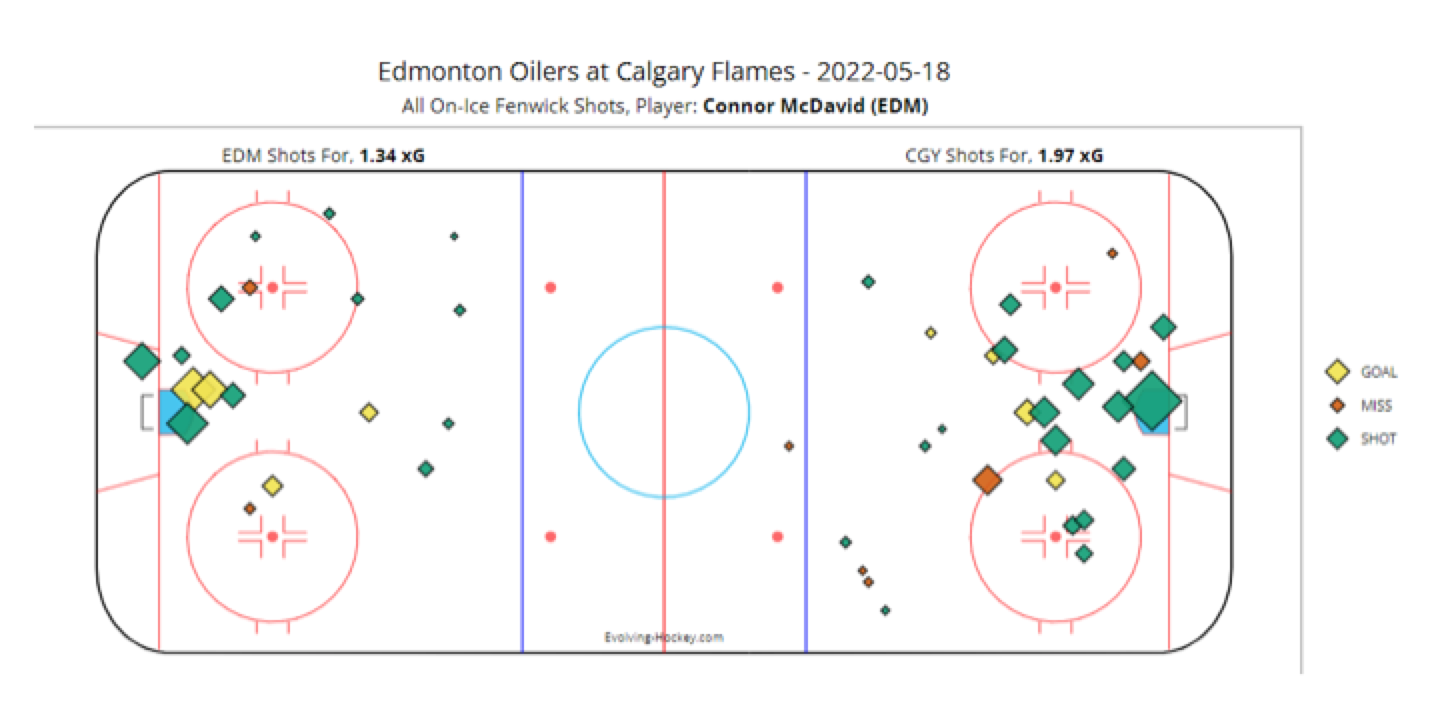May 19, 2022
Flames' goal is to survive the McDavid minutes
The Flames have depth, but the Oilers have star power. Barring a complete goaltending collapse, the outcome of that clash will decide the latest chapter in the Battle of Alberta, Travis Yost writes.
By Travis Yost
Before the start of the Battle of Alberta, I had a few theories as to how the series would play out. Chief among them: Calgary is the better team, Edmonton has the best player, and, by extension, the best line.
Barring a goaltending collapse from either club, these two forces would collide and ultimately decide the series.
Game 1 checked all three of those boxes. The Flames were comfortably the better team. The Connor McDavid line was as lethal as usual. And, ironically, we saw goaltending capitulation from both sides.
Edmonton’s Mike Smith (three goals conceded on seven shots faced) was horrific and yanked from the game early. Backup Mikko Koskinen (five goals conceded on 32 shots faced) wasn’t any better. The only difference between Smith and Calgary starter Jacob Markstrom (six goals conceded on 22 shots faced) was Darryl Sutter’s reticence to pull his besieged goaltender. It was bad.
Let’s set the goaltending aside for a moment – after all, it’s exceptionally rare you see a single-game stop rate of 80 per cent. Instead, let’s focus on the first two components: Calgary’s dictation of the game, and Edmonton’s ability to keep the game close on pure star power from the McDavid line.
Starting with Calgary: this was, for all intents and purposes, a possession-game beatdown. Consider what the numbers looked like at even strength:

It doesn’t matter if you are looking at pure shot volume or adjusting those shots for their threat level, the Flames were a far superior team and dictated the flow throughout the game.
We know that Calgary’s lineup runs a little bit deeper than Edmonton’s (particularly on the blueline), so much of this is expected. Notably, all four Calgary lines were in the green on the night, and three of the four lines outscored Edmonton at even strength. This is the type of comprehensive dominance you tend to see from Stanley Cup-calibre teams:

It was a great night for virtually every Calgary Flame except Markstrom. Andrew Mangiapane, Johnny Gaudreau, and Matthew Tkachuk (hat trick) had three points apiece. Twelve skaters recorded at least one point. The only skater who didn’t record a shot on the night was fourth-line quasi-enforcer Milan Lucic.
And yet, this performance from Calgary left me wanting. Sure, Markstrom struggled. But why did it feel like the Oilers, despite being comprehensively outplayed, were on the precipice of an improbable comeback?
That brings us to the McDavid line. Calgary’s path to victory means slowing the McDavid line down, as much as practically possible. He is coming off one of the most dominant playoff performances I have ever seen against Los Angeles.
I was very curious as to how Sutter, a gifted defensive coach, would attempt to slow down McDavid from a personnel standpoint – particularly with last change.
The Flames don’t have any single unit capable of defending McDavid, but they do have a lot of skilled two-way players and can throw a lot of different bodies at the problem. And that’s primarily what they did. The Flames rolled three lines and three pairings against McDavid, only shielding the Lucic-Trevor Lewis-Brett Ritchie line in the process.
That said, Sutter did skew towards best-on-best. Tkachuk, Gaudreau, and Selke Trophy finalist Elias Lindholm – anchored by Noah Hanifin and Rasmus Andersson – were asked to do quite a bit more:

How would we grade the Flames work against McDavid in Game 1? I think it’s a bit of a mixed bag. On the positive side of the ledger: as a dominant possession team, Calgary can execute the most tried-and-true defence there is against a player the calibre of McDavid, and that’s not to let him touch the puck. The Flames outshot the Oilers 29 to 19 (+10) with McDavid on the ice, taking meaningful puck-on-stick time away from Edmonton’s top line. They also outscored the Oilers 5-4 against McDavid, though there is a lot of goaltending noise in that data.
On the negative side? Those four goals scored by the Edmonton top line came from surgical attacking sequences, usually on the heels of some freakish individual effort. (See: here and here!)
The key question for the Flames: can they continue to ramp up the offensive pressure and pin McDavid’s line (featuring Evander Kane and Leon Draisaitl, primarily) into the defensive zone like they did for stretches in Game 1?
The McDavid line was still responsible for four goals – and you can see why from the chart below – but there is no question the Oilers had a hard time sustaining offensive-zone pressure, relying heavily on the rush and counterattacking measures to threaten Calgary. Consider the shot profile with McDavid on the ice:

That is an awful lot of traffic in front of Smith and Koskinen, and it’s one of the reasons Edmonton’s goaltenders melted all night.
But Calgary wasn’t clean defensively, either. McDavid’s line was able to generate heaps of scoring chances at the net mouth and from the circles, and it didn’t seem any of the Flames’ defensive pairings were strong or agile enough to push McDavid (or Draisaitl/Kane, for that matter) into less dangerous scoring areas.
All this to say: I think Calgary’s performance was masterful last night, save for Markstrom. But the McDavid minutes were terrifying, and that’s with the Oilers’ top line playing extensively in their own zone. If that regresses even marginally, it’s going to mean more offensive-zone pressure from the McDavid line.
Calgary’s goal is simply to survive the McDavid minutes. In Game 1, they did just that. Repeat it three more times this series, and Calgary will move on. But I’m not betting against No. 97 anytime soon.
Data via Natural Stat Trick, NHL.com, Evolving Hockey, Hockey Reference

